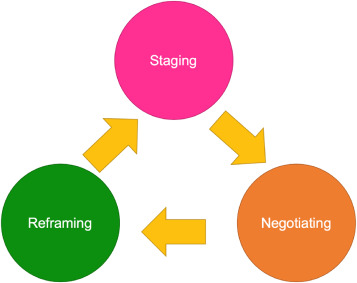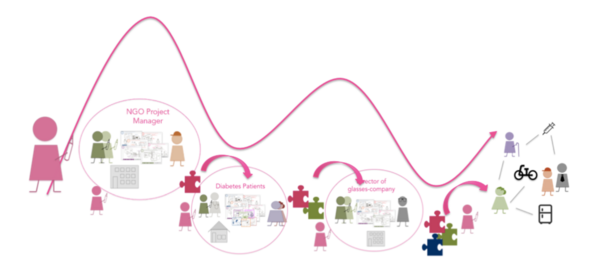Staging negotiation spaces in project management
Contents |
Abstract
Climate change is a big challenge in the 21st century and necessitates the efficiency that advanced engineering systems can provide. When developing such systems, it is important to understand the difference between those, who use systems and those who build them as they have different success criteria.[1] Trying to combine the system builders’ and the system users’ needs, many projects are of a collaborative nature. However facilitating processes is crucial to be successfully completed regarding cost, timescale and performance.[1]
Project stakeholder management is as much about identifying and analysing stakeholders and their impact on the project, as it is about developing appropriate management strategies for effectively engaging stakeholders in project decisions and execution.[2]
Many projects cracked the code and use socio-technical methods in their involvement of stakeholders, but as projects are iterative processes, circulation and repetition with small changes should be found in the way we work in projects.
The purpose of this article is to emphasise how the strategic framework staging negotiation spaces can give direction to and speed up internal meetings as well as external meetings in projects. Thereby the framework touches upon efficiency versus effectiveness, which is crucial when reasoning a project.
Furthermore with key aspects as staging, facilitation of negotiations and re-framings as an outcome of negotiations, the framework is suitable for project stakeholder management. Introducing the theatre metaphor, which the framework builds upon, it is clear how terms backstage and frontstage can be a common perception of how to interpret and prepare meetings in a project.[3]
Introduction: The metaphor of a theatre
As the word staging indicates, the framework “staging negotiation spaces” is based on a theatrical metaphor, where a director and the team associated are setting the scene for actors to perform a play. The play has lines, artefacts and expressions that altogether become a manuscript. By the same means project managers can be seen as directors who’s degree of freedom is strongly related to the production’s budget and positioning.[4] The project manager has to direct the team, which furthermore has to direct stakeholders who are invited onto the stage. The staging metaphor has been used in terms of participatory design, but the framework staging negotiation spaces seeks to expand the theatrical metaphor to include staging within a team of design engineers. In this article design engineers are translated into a project team, which emphasise the multidisciplinary team that advanced engineering system builders consists of.
Stage, negotiate and reframe
To outline the framework it is essential to introduce three interconnected aspects, namely staging, facilitation of negotiations and re-framings. These aspects have their origin in science and technology studies (STS) and actor-network theory (ANT), which are both very established understandings in the vocabulary of a design engineer.[4]
1. Staging
When the project manager sets the scene, that person is expected to provide their team with a script in terms of an outlined plan or project, as well as they are expected to provide artefacts in terms of working structures. The phrase staging fits the theatre metaphor, but should be taken with a grain of salt as stages through STS can be seen as a temporary and spatial space.[5] However the framework distinguish between backstage where the people working on the project interact, and frontstage where the project team invite stakeholders to interact and co-create.[3] To engage stakeholders the project team will beforehand discuss in which space the stakeholders are brought together and which artefacts should make them interact. Lastly they plan the meeting to make sure that they cover all the desired subjects.
Hence staging is, as the metaphor indicated, about setting the scene either as a project manager or as a team member working on a project.
2. Facilitation of negotiations
As a project evolves the project team members have perceived events differently, just like stakeholders have different relations to a given problem. For the project to keep evolving the project team members have to align their perceptions, just like stakeholders have to comprehend each other’s concerns.[6] In the term of staging negotiation spaces, this is called negotiations and relates to the stakeholders way of framing their concern. To make sure negotiations remain constructive the facilitator has a toolbox. What is in this toolbox depends on the facilitator’s background and therefore their ability to apply methods or objects to such stages.
Hence facilitation of negotiations comes down to provide team members or stakeholders with tools to get on a common ground in their understanding of the subject.
3. Re-framings
Often the stage holding a negotiation creates an opportunity to re-frame the problem or a given situation. As the term indicated, re-framings are about having an explorative approach and thereby being open to learn from every negotiation. Are stakeholders brought together in a well-staged and facilitated negotiation, the project team will afterwards know more about the desired subjects and possibly able to rephrase the problem in terms of their interpretation. It is also a possibility for them to rearrange the stage and facilitation of negotiations with the experience from the previous negotiation.
Hence re-framings focus on the iterative aspect of a project, where project teams or managers learn from their staging and facilitation of negotiations, so that deliberate adjustments will lead the project in the right direction

Configuration of spaces
By operating the three above-mentioned aspects negotiation spaces are configured. As it shows in figure 1, a part of this configuration is inscription. Inscriptions are relevant because they make it possible for the project team to represent either their or a particular matter in objects. Latour refers to inscriptions as: “all the types of transformations through which an entity becomes materialized into a sign, an archive, a document, a piece of paper, a trace” [7] By bringing inscripted objects to a negotiation the project team can influence the direction of the negotiation between stakeholders, and the framework staging negotiation spaces becomes a more strategic tool. If the project team negotiates their different areas of knowledge to the case or interpretations from negotiations with stakeholders, then the activity is happening backstage and maybe facilitated by the project manager. Is the project team creating a space by bringing stakeholders and inscripted objects then the negotiation is happening frontstage. [3] Either way following the framework the project team interpret negotiations and reframe a negotiation space or the direction of the project to evolve. Hence the configuration of spaces is rooted in previous experience within the project, which is creating these loops and thereby underlines the iterative nature of the framework.

- How can inscription and interpretation create loops?[8]
- How does the framework relate to project management? Mainly regarding the aspect of people, but is a strategic tool which can have an effect on efficiency/effectiveness.[2]
Staging negotiation spaces in management
- Explaining how the framework can be applied on a project, program and portfolio level.[2]
The performance of staging negotiation spaces
- A description of how the use of the framework can improve the teams process and be a internal tool on par with an external strategic tool.[6]
Disadvantages
- Reflection on how downsides such as time for planning and alignment can cause delays in projects, but also improve the outcome.
- It is probably necessary to make a tade-off
Conclusion
- Connecting the above in a general conclusion on how the use of staging negation spaces as a strategic framework can improve project management
Annotated bibliography
First and foremost it is suggested to read the literature, which seeks to exploit the potential within the theatrical metaphor and expand it to include more than just participatory design. It is then suggested to dive deeper into different ways of facilitate interaction in a world, which is becoming more and more interactive.
- Brown, N. C. (2020). Design performance and designer preference in an interactive, data-driven conceptual building design scenario. Design Studies.
- Pedersen, S. (2020). Staging negotiation spaces: A co-design framework. Design Studies , pp. 58-81.
- Pedersen, S., & Brodersen, S. (2020). Circulating objects between frontstage and backstage: collectively identifying concerns and framing solution spaces. In C. Clausen, V. Dominique, S. Pedersen, & J. Dorland, Staging Collaborative Design and Innovation: An Action-Oriented Participatory Approach (pp. 72-85). Edward Elgar Publishing.
Cite error:
<ref> tags exist, but no <references/> tag was found
